Emily Lakdawalla • Dec 09, 2013
Curiosity results at AGU: Gale crater rocks are old, but have been exposed recently
My head is swimming from this morning's Curiosity press briefing here at the American Geophysical Union meeting in San Francisco. They talked about a lot of stuff but the really ground-breaking result is the fact that they have successfully used Curiosity's science instrument package to age-date their one drilled rock sample in two totally different ways. The work has just been published as Kenneth Farley et al., "In Situ Radiometric and Exposure Age Dating of the Martian Surface". This is a big, big deal.
There are two kinds of age dates we're talking about here. The first one has to do with the age of the rock itself -- when did the geology happen that built this rock in the first place? The answer to that question is: between 4560 and 3860 million years ago. Which is really ancient (the upper age limit, you may notice, is the age of the solar system). And the second one has to do with how recently the rock has been exposed at the surface. The answer to that question is: 48 to 108 million years. Which is relatively recent, especially for Mars.
I just wrote two long blog entries about relative age dates on Mars derived from crater counting and from stratigraphy and spectroscopy. I explained in an earlier post how difficult it is to put actual numbers on these relative time scales, even for Earth, and I didn't even bother showing you absolute time scales on Mars. Now I'm regretting that! How do these age dates fit in with what I've told you about Mars' history?
The Rocks Are Really Old...
First, I have to back up and give you some context about the rock under discussion. Remember that Curiosity is in a crater, Gale crater. Curiosity landed in the flat northwest floor of the crater. The crater's rim is "dissected," meaning that erosion has eaten away at it, carving canyons into it. Rocks and sand and silt from the crater rim, and also from outside the crater, would have been transported by flowing water into the crater and deposited on its floor.
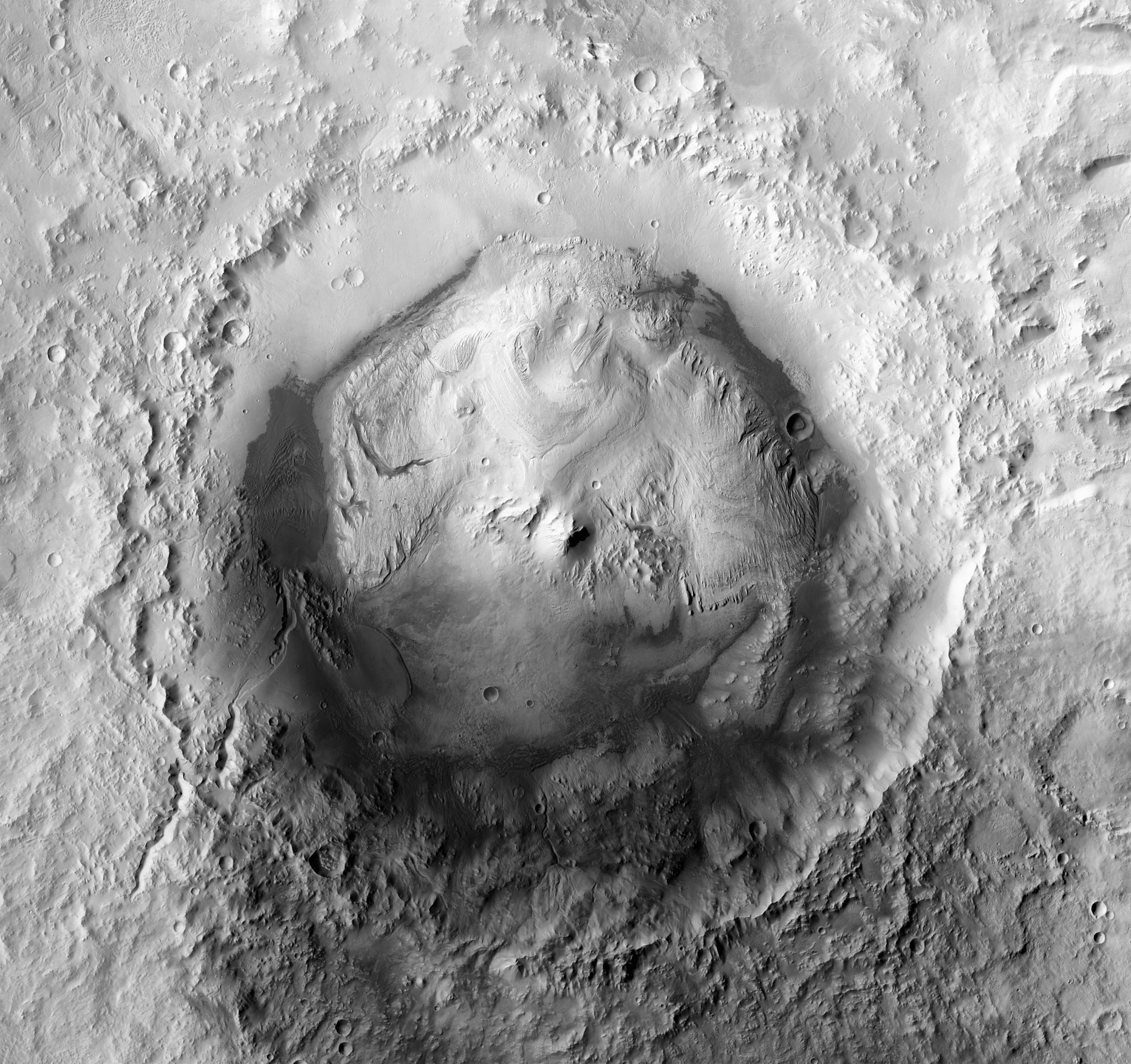
When Curiosity landed, she saw some evidence for that river transport in the form of gravelly rocks. But she drove past these downhill into an area that the science team called Yellowknife Bay. In Yellowknife Bay, the rocks were much finder-grained -- they were mudstones. While there, Curiosity tried out her drill for the first time, drilling two holes, called John Klein and Cumberland. I wrote before about some early results from the first drill hole, John Klein, that proved that Curiosity was sitting on an ancient Martian lakebed.
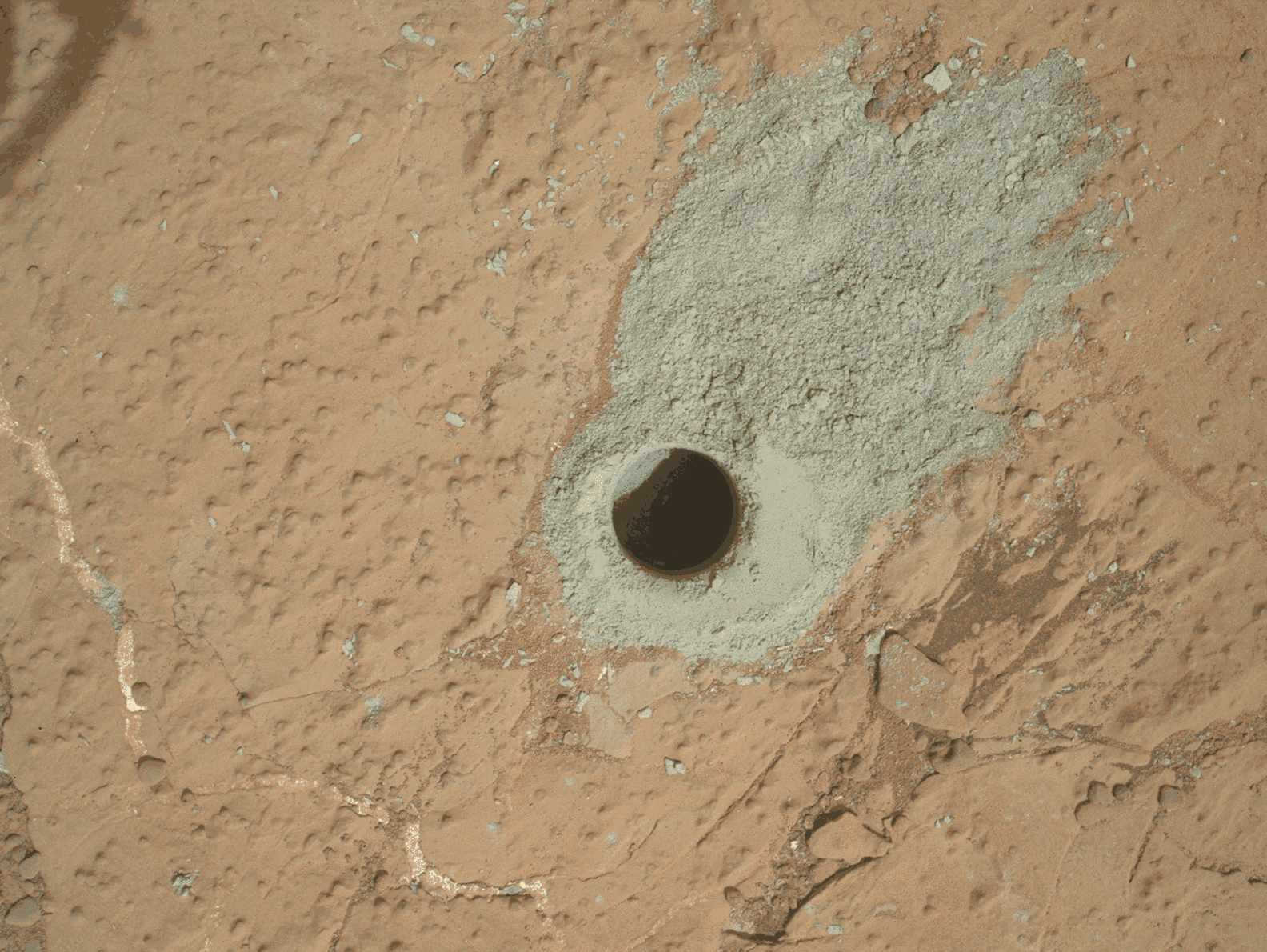
The age analysis began with the use of the Alpha Particle X-Ray Spectrometer instrument on the end of the robotic arm to determine the bulk elemental composition of the rock. The rock is fairly rich in potassium, which is awesome because one isotope of potassium -- potassium-40 -- spontaneously decays over time to produce argon-40, with a half-life of 1.25 billion years. Assuming that the rock ultimately began as an igneous one that cooled from a melt (as all rocks do, if you trace them back far enough), it originally would've contained no, or nearly no, argon-40. But once it's locked into a solid form, the argon-40 that's produced by decay of potassium-40 is stuck within the rock. If you heat rocks enough, any accumulated argon-40 can and does diffuse out, so it is possible to "reset" the age of a rock without melting it. The Gale impact was big enough that it probably reset the potassium-argon ages of the rocks immediately surrounding it.
So they took some rock powder drilled from the Cumberland drill hole and heated it within the SAM instrument, which did release the argon, and they counted how much argon-40 came out of it. There was a lot of argon in the Cumberland rock sample. A lot. So much that it yielded a very high age, 4.2 billion years old, give or take 350 million years. Typically, when you're concerned about the accuracy of a potassium-argon date, you're concerned with things that can allow the argon to escape from the system, which will result in you determining a date that is younger than the rock's actual age. But this rock has so much argon in it that it must be preserving most of the argon that ever developed in it, and it must really be old. Now, it's not surprising that a Mars rock is old, but it is a lovely surprise to be able to measure a rock as being that old. On Mars.
What does this old age mean? It is not necessarily the age of the lake that the rock formed in. In fact, it might have nothing to do with the age of the lake. Remember that sedimentary rocks are made of broken up bits of pre-existing rocks. This is true of the Yellowknife Bay formation, a mudstone formed of material that originated on and maybe even outside the rim of Gale crater. This picture attempts to show you that the material that Curiosity is age-dating likely originated outside the crater -- it's stuff that was there before the crater formed.
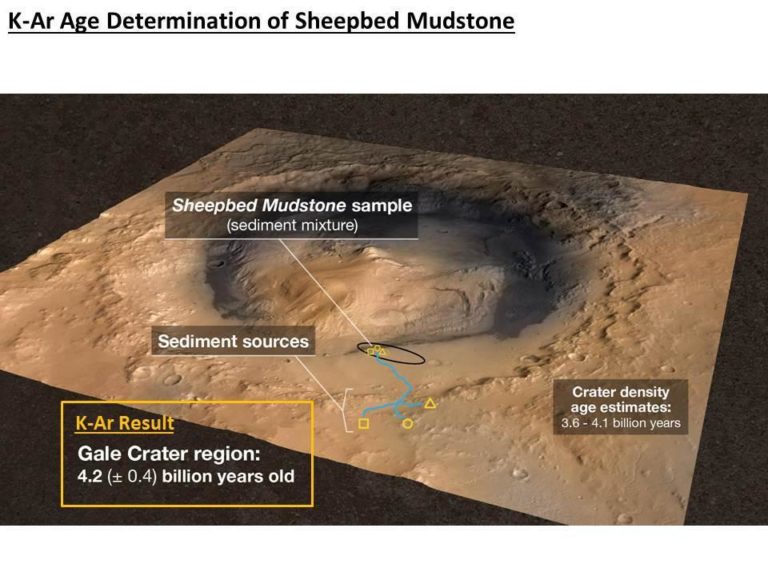
Now, one of the big questions about clays on Mars is: where did they form? Did they form like most clays on Earth do, when abundant water on the surface attacked rock minerals and altered them and wore them away and transported them somewhere else and then deposited them? Or did they form in situ, by groundwater altering the composition of an original rock in place? The first one requires a more Earth-like climate; the latter could happen at depth on Mars or in certain special places like volcanic or impact cratering environments even if the surface climate is like today's. One of the things they talked about a lot at today's press briefing is that in terms of bulk chemistry (the amount of each chemical element present in the rock), the sedimentary rocks that Curiosity is looking at don't look any different from igneous rocks. What that tells you is that the original source region for the sediment didn't spend a lot of time exposed to water alteration before the sediment was transported into the basin.
So what we take away from this is that the age of the rocks in the Gale crater region -- and therefore the Gale impact -- is 3.86 to 4.56 billion years old. Which is old old old. It only barely gets to the age of the putative Late Heavy Bombardment on the Moon. But it matches very well with the age estimates for the region based on the attempts to use estimated cratering rates to calibrate the crater counting time scale -- 3.6 to 4.1 billion years.
This age estimate is not precise enough to discern among a couple of competing methods for calibrating relative age time scales to absolute time scales, unfortunately. I asked Farley a couple of questions after the briefing and it does not appear that Curiosity will be able to do any better than this in terms of precision. This is no criticism -- it's wonderful they achieved what they did, and it's wonderful that it corroborates crater-counting age estimates.
What this really does is to give confidence that an instrument specifically designed to perform K-Ar age dating would be able to achieve excellent results on Mars, and I would hope that a future rover mission would have this capability. One thing that SAM cannot do is to measure the mass of material that has been delivered to a sample cup, and not knowing how much mass you have in the cup limits the accuracy of your estimate of how much potassium was in the sample to compare with the amount of argon that came off. They have done a ton of work in the laboratory to produce estimates of how much mass was delivered to SAM, but there are still pretty big error bars for this measurement -- they estimate the mass to be 135 plus or minus 16 milligrams -- so it would be nice to be able to measure that more precisely; that, in turn, would make for narrower error bars on your age dates.
...But the Rocks Were Exposed Recently
So estimating an ancient rock age was only half of the cool age-dating result. The other one has to do with how long the rocks have been exposed at the surface. Mars lacks a significant magnetic field, so anything on its surface is exposed to bombardment by galactic cosmic rays. Galactic cosmic rays can produce specific isotopes of noble gases: argon-36, neon-21, and helium-3. These gases would not have been present in the rocks when they first formed, so if you know the rate at which the isotopes are produced on Mars, and if you measure their abundance in current rocks, you can estimate how long the rock has been exposed at, or near, the surface. (Galactic cosmic rays can penetrate two or three meters down into the surface.)
The exposure age for the Cumberland rock was surprisingly young, only about 80 million years. That means we have a rock that formed 4000 million years ago that sat around for almost all of that time -- 98 percent of that time, in fact -- and has only been exposed at the surface about 80 million years ago. At the press briefing they showed evidence that the mechanism that has exposed this rock is wind erosion. For example, here is a MAHLI image (MAHLI is the hand-lens imager on the end of the arm) of the surface of some Yellowknife Bay mudstone. It's so cool how the wind has scoured mudstone away, leaving the nodules raised above the surface, with windtails behind them, in the lee of the nodules.
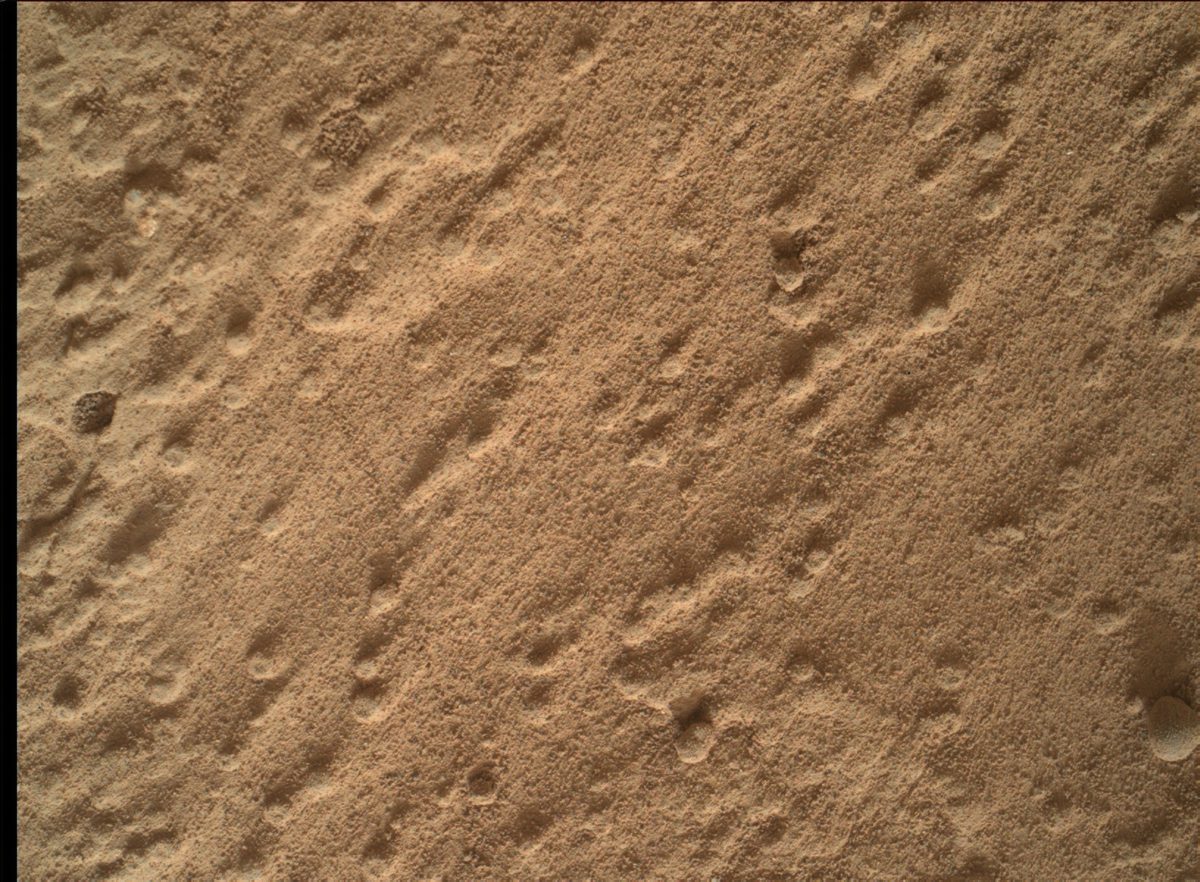
Measuring the exposure age is a neat result in and of itself. The derived age is a lot younger than scientists anticipated -- it means erosion is happening quickly, and is an ongoing process, recently (and probably continuously) active. They can't say anything about why it's happening now and not, say, 3.5 billion years ago.
But this result leads to another result. If you sit in Yellowknife Bay, as Curiosity did, and look around you, you can see ledges of material marching upward, stepwise, around you.
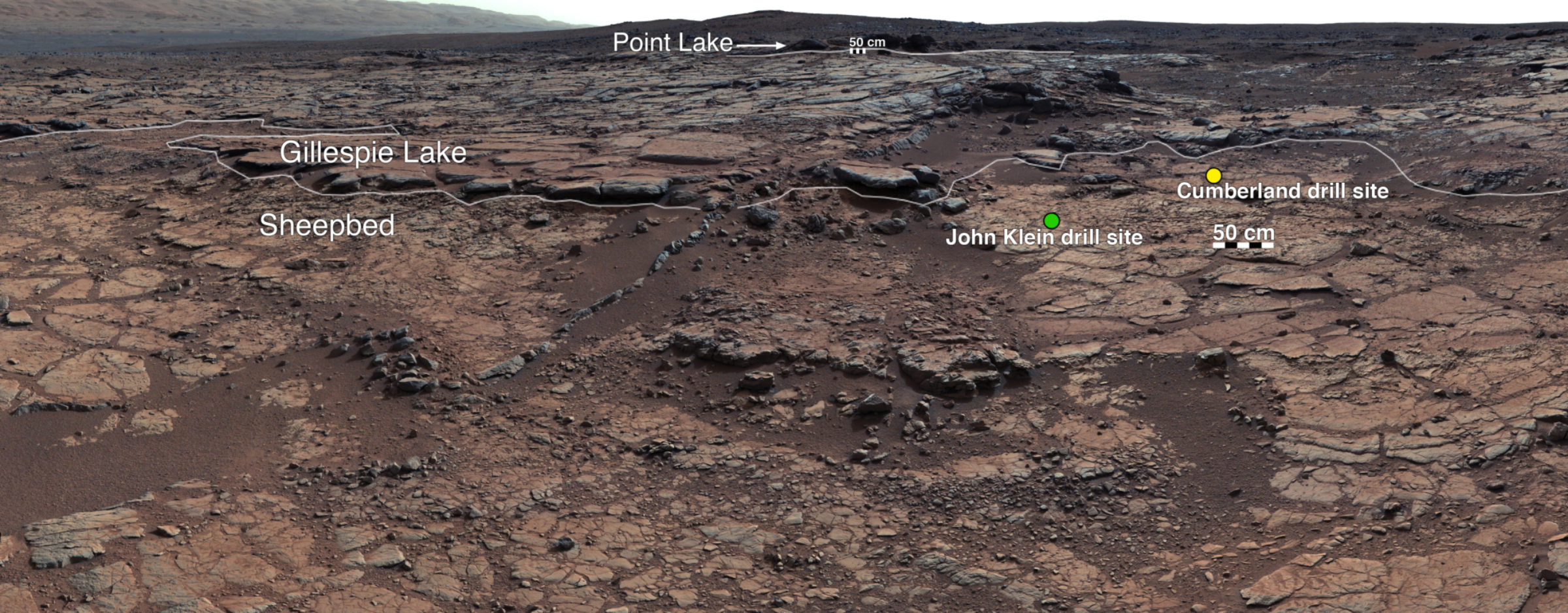
The two drill holes were in the Sheepbed unit, at the base of this sequence. Then there's a ledge of resistant rock -- that's the Gillespie Lake member. Then another step up, to the Point Lake member. The Sheepbed unit is fairly easy to erode. Here's a better look at that:
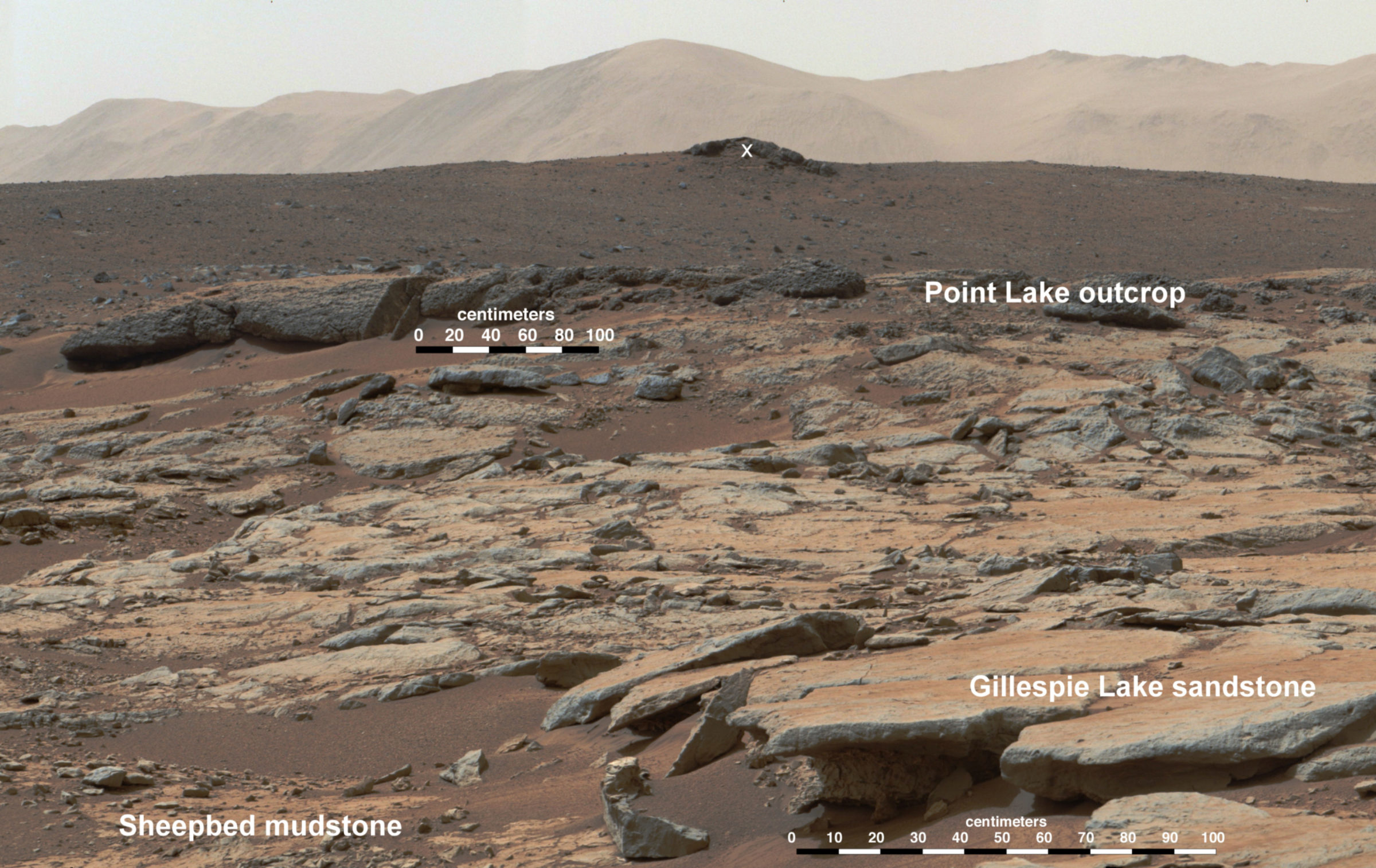
You can imagine how the relatively weak mudstones of the Sheepbed Unit are getting sandblasted away by wind scouring, and that's undercutting the more resistant layers like Gillespie Lake. In other words, the Sheepbed rocks are being exposed by a process of scarp retreat. Assuming that this is a continuous and ongoing process, if you follow the direction of the wind, then, until you get to the scarp, that'll take you to Sheepbed rocks that should be freshly exposed. You can estimate the rate of scarp retreat, and it's about 1 meter per million years.
Again, a nifty result, but it's most important because it leads to something else. Those galactic cosmic rays don't just produce noble gases. They can also be really horrible for organic compounds. Curiosity has, as yet, detected no large organic compounds in the drilled samples from Cumberland or John Klein. That could be because the rocks didn't contain any organic material to begin with. But that's kind of surprising. We're talking about mudstones, made of very fine clay, deposited in a lake, in a basin without an exit. Organic material should've been there to begin with (it would have arrived on meteorites, even if there never was any organic material produced by critters on Mars), and it should have settled out of the lake where fine mud was also settling out of the lake. So it's actually a more likely scenario that there was organic material deposited in the Sheepbed mudstone and that either Curiosity has not detected it yet (there are a couple of possible reasons why that could be), or it has been destroyed since its deposition. Exposure to galactic cosmic rays could've destroyed the organics that might have been in those surface rocks, exposed for 80 million years.
But if we know where the most recently exposed rocks are, Curiosity might be able to drive right up to them and maybe find organics there, before galactic cosmic rays have had a chance to destroy them. If they're right about how the Sheepbed mudstone is being exposed, by scarp retreat, then what Curiosity needs to do is to drive up to a site of current active scarp retreat -- the downwind edge of a retreating scarp. Curiosity is absolutely not going to drive back to Yellowknife Bay to do this. She doesn't have to; the team has spotted more such sites from orbit. One of them is coming up along the drive, the stop labeled "Waypoint 4" on this map:
Here's a closer look at that site, compared to Yellowknife Bay. John Grotzinger estimated that they'd get to this spot in about two months. Once they do, they need to assess whether it really does appear to be a site of active scarp retreat. If it is, then they'll settle in for a drilling campaign, getting the rover as close to the base of the scarp as they can safely. I talked with John about this after the briefing, and asked if they'd want to try to test the hypothesis of exposure age being related to scarp retreat by drilling more than one hole at different distances from the scarp. He said that'd be a nice thing to do but would probably take more time than they want to, since it pretty much takes three weeks to do a complete drill campaign. He said that if they did consider two drill holes, rather than doing two drill holes on the lower member, what they'd really want to do is one on the lower member close to the scarp, and one up on top of the scarp, in the next unit up; that would give you two different lithologies and should also be starkly different exposure ages, if their hypothesis is correct. I asked him how high a scarp they can put the drill on, and he said they were working on figuring that out.
Some Stray Final Thoughts
One of the reasons they're getting so much work out of the Cumberland sample is because they still have a lot of material stored inside CHIMRA, the sample handling system on the arm. Whenever they have some spare time when they have to sit in one spot (as does happen often on weekends) they can command Curiosity to take another bit of that sample and drop it in to SAM to do a slightly different analysis. Whenver they stop to drill another hole they'll have to dump the rest of the Cumberland sample first. But that may not be the end of Cumberland analyses. Jennifer Eigenbrode told me that they've dropped a few Cumberland samples into SAM chambers for no particular reason, just keeping them for later use; she said the team calls this "doggie bagging." She said that they've now done so many analyses on Cumberland that it can almost serve as a standard for the SAM instrument -- a later analysis of Cumberland material can be used to check that SAM is performing the same way, later in the mission, that it is now.
John pointed out that if they do two drill samples in one location, as I suggested for Waypoint 4 above, they'll have to dump the first sample before they can acquire the second sample, which is sort of a problem, though it can be mitigated by doggie bagging some of the first sample. (Writing that just now, I'm not sure how much I like the phrase "doggie bagging." It made me laugh at first but now I want to say "caching." Except "caching" on Mars has its own set of connotations. ...Excuse my maundering, it's been a long day.)
I'm very pleased to hear that science results from the mission can be used to modify their approach to fieldwork to possibly improve the future science they get out of the mission. In the past, missions have often been too short-lived or inflexible to manage that, but with the trend toward longer-lived spacecraft enjoying lengthy extended missions we've been able to take science results from early in the mission and make smarter investments of time and money in extended missions to multiply the value of the science we get out of them. You see the same thing happening on Cassini, and Opportunity, and the Mars orbiters, and MESSENGER.
John made another interesting point to me about today's results: he pointed out to me that Ken Farley is a Participating Scientist. This is a scientist who has not been on the Curiosity mission from the start; he proposed to NASA's Research and Analysis program to get grant funding to work on a specific type of project using Curiosity data that the existing team hadn't thought of doing. Participating Scientists are a way that NASA makes sure that we get the most science out of a mission that we can, using diverse approaches that may not have been anticipated at the outset. This is one kind of work that's threatened when Research and Analysis funding gets cut. I've heard rumors (only hallway rumors, so don't bank on this) that there may not be Participating Scientists on Dawn for the Ceres part of the mission because of the budget squeeze that NASA's Planetary Science Division is under.
Phew! There was quite a bit more from Curiosity at AGU, and there'll be more to report on tomorrow. Stay tuned!
Let’s Go Beyond The Horizon
Every success in space exploration is the result of the community of space enthusiasts, like you, who believe it is important. You can help usher in the next great era of space exploration with your gift today.
Donate Today

 Explore Worlds
Explore Worlds Find Life
Find Life Defend Earth
Defend Earth


